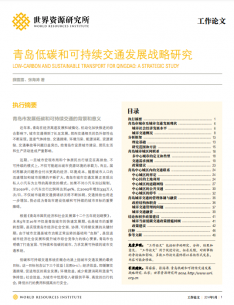Low-Carbon and Sustainable Transport for Qingdao: A Strategic Study
The coastal city of Qingdao, in eastern Shandong province is undergoing a period of rapid urbanization and motorization along with much of the rest of China. However, the existing and future transport challenges make it increasingly difficult for the city to become a sustainable and livable city. Without effective measures in place, Qingdao is very likely to be locked into a car-dependent path with mounting emissions. Based on extensive interviews and field studies, the study unrevealed various urban transport challenges that Qingdao confronts. It further suggests a handful of holistic approaches, including planning, fiscal measures, regulatory measures, and infrastructure provisions to reverse the unsustainable trend.

Fueled by the rapid economic growth, urbanization, and motorization, the negative externalities associated with the urban transport sector in Qingdao are also escalating: in 2011, traffic congestion has led to 1.8 billion RMB of direct economic loss, equivalent to 3% of the city’s GDP. In parallel, the CO2 emissions of the transport sector are about 21% of the total emissions; by 2020, transport-related CO2 emissions will at least consist of 29% of the total emissions, becoming the most fast-growing sector. In addition, tailpipe emissions are also the main culprit of the bouts of smog in the city.
The challenges of the status quo and future add an additional layer of complexity to the city’s goal of sustainable and livable development. Without proper interventions, the city is very likely to be locked into a car-dependent path. To reverse the trend by then will be much more costly than acting now.
Solving these challenges requires some profound solutions. The study concluded that the urban transport challenges in Qingdao are attributable to the following aspects:
- Disconnection between land use planning and transit planning,
- Excessive expressways, arterials and super block designs,
- Poor design and management of public transit system and the overlooked rights-of-way for pedestrians,
- The overall neglect of travel demand management instruments,
- The strong aspiration for personal vehicle ownership, the overlook of the external social costs associated with vehicle usage, and the lack of controls over car ownership and usage,
- Limited funding appropriated for public transit,
- Government fragmentation and uncoordinated administrative system,
- Lack of ex-post evaluation and monitoring mechanisms to hold decision-makers and operators agencies accountable.
The city does not have a consistent goal or an overriding framework to guide its urban transport development. It also frequently relies on reactive and ad-hoc approaches aiming at low-hanging fruits. Such solutions focusing on infrastructure provision and vehicle upgrade have not only bypassed the rapid-growing private vehicle sector, but also missed out the window of opportunities for changes. Therefore, this working paper makes the following suggestions to remedy the above problems:
- Define a common sustainable and low-carbon goal. Currently, the city has multiple and conflicting goals so that many of the city’s initiatives end up either giving way to the political agendas of certain officials, or they are half-heartedly implemented. What is needed is a clearly-defined sustainability goal to bind the various initiatives together and to back them by a strong united political will. This goal should reflect the vision of the city as held by various stakeholders and should reconcile all conflicts of interests.
- Deploy holistic, integrated sustainable transport solutions. The city needs a clear roadmap marking out its options, identifying priorities, making sure that there are the necessary resources (funding and implementation capacity), and setting up timelines and milestones. Solutions should be proactive and holistic and include the integration of land-use and transport planning, the improvement of public transport, travel demand management, and public education campaigns etc.
- Build effective institutions for sustainable transport. Qingdao will be able to implement sustainable transport policies if it places all tasks related to transport development and management under one central authority. This includes both vertical integration (planning, construction, operation, and enforcement) and horizontal integration (public transport, private vehicles, and non-motorized transport). Currently these are spread around a number of different municipal departments.
- Explore diverse funding options. Subway construction and operation are capital-intensive, and the local government does not have the resources to recover these costs. The government needs to rely less on revenue from land concessions and government loans and look for other sources of funding such as land value capture to fund improvements to public transport and railway infrastructure.
- Establish a sound monitoring and evaluation mechanism. An effective monitoring and evaluation system is needed to guide the transport sector onto a sustainable track and hold decision-makers accountable. This requires evidence-based and outcome-driven performance indicators and a transparent reporting system that combines top-down and bottom-up monitoring mechanisms.